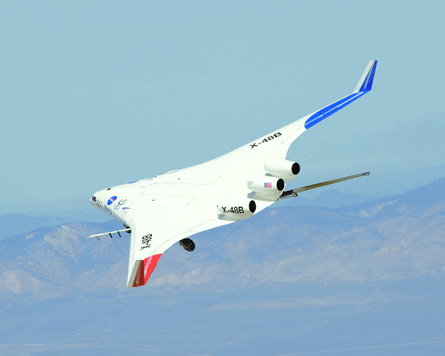The Boeing X-48B blended wing body (BWB) scale-model demonstrator, called Low Speed Vehicle 2 (LSV2), or ship two, was set to fly the second in a series of seven flights with slats retracted on 11 April, which would be its 13th flight in total.
Based at NASA Dryden Flight Research Center in California, the LSV2's latest flight is one of seven known as the slat retract envelope expansion block tests. It is the second of six planned blocks. The LSV2 is one of two mass and geometry accurate 8.5% scale-models built by the UK's Cranfield Aerospace for Boeing Phantom Works, which is working in co-operation with NASA and the US Air Force Research Laboratory. The BWB models are of a notional 450-passenger airliner but any production vehicle would likely become a US Air Force fuel tanker or cargo carrier. The remote-controlled LSV2 has a 6.4m (21ft) wingspan, a maximum take-off weight of 238kg (525lb), trailing edge control surfaces but fixed slats.
 |
|---|
© Carla Thomas/NASA |
"With slats retracted the take-off and landing approach speeds are about 70kt (129km/h), 15kt higher than with slats extended," says Boeing X-48B chief engineer Norman Princeon.
The size of the demonstrators precludes a slats articulation mechanism, so the slats are fixed. The 12th test and the first slats-retracted flight was on 4 April. On that occasion LSV2 landed with 6.81kg of fuel left after a 33min flight. Before that, under block one, 11 flights with slats extended took place, including LSV2's July 2007 maiden flight.
Due to LSV2 having less endurance than was expected, the BWB team is proposing to increase the test programme to 35 flights. To overcome the endurance limit a turbofan might be developed from a JetCat turboprop. Princeon expects this could halve the LSV2's fuel burn. NASA researchers are also proposing uses for LSV2 that could further extend its use, such as altering the flight control laws. The Boeing roadmap for the X-48B includes modifying the wing shape and adding engine shielding to create a quieter version, but this has not yet been approved.
For such a change the LSV1, or ship one, would be modified first and then windtunnel tested. Boeing's quiet BWB design is different to the Cambridge-MIT Institute's silent aircraft initiative design. Boeing's LSV1 wil be on display at the Smithsonian Folklife Festival in June and July as part of NASA's 50th anniversary celebrations.
Source: FlightGlobal.com
















